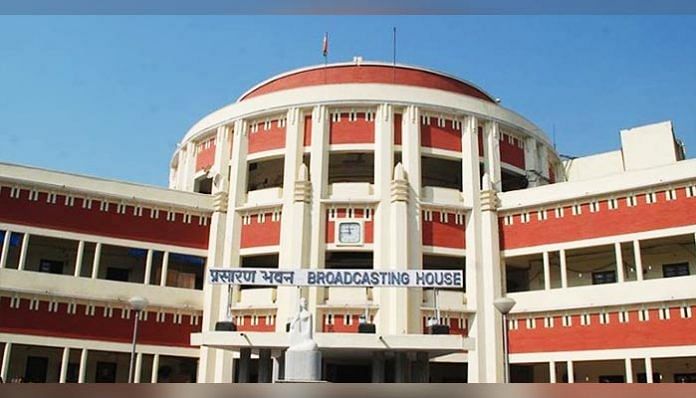New Delhi: India’s commentaries on the “unnecessary transgression” by China in Ladakh and other messages sent via radio waves might not be reaching the country as it has possibly “jammed” the signals.
ThePrint reported last week how India has started putting across its word on multiple issues concerning China amid the border standoff to the Chinese audience through the state-owned All India Radio’s (AIR) Chinese service.
India has, so far, broadcast in Mandarin commentaries of experts on China and strategic affairs on several topics, ranging from the Galwan incident, where they said China had been “transgressing along the boundary unnecessarily”, to commentaries on China’s role in the South China Sea and its economy.
However, multiple open source intelligence networks have since then pointed out that India’s words may not be reaching China at all as it is jamming shortwave radio waves, which carry the Chinese radio signals.
20:44JST (11:44UTC)
ALL INDIA RADIO 17510kHz Chinese
Tx QTH: Bengaluru ??(500kW Az38)
20:45JST (11:45UTC)
CNR 1 Jamming 17510kHz ?
Rx: Nooelec NESDR SMArt + Airspy SpyVerter R2 + 9m random wire#shortwave #DXing #WashYourFoot pic.twitter.com/14oMBV0XxT
— atake? (@atake) June 8, 2020
Jose Jacob, who contributes for the World Radio TV Handbook and is an expert on shortwaves, told ThePrint China has been jamming frequencies carrying the AIR Chinese service as well as the Tibetan service with music and other noise.
“This creates disturbance and thus listeners there are not able to hear it clearly. But this is not the first time. China regularly jams Indian radio signals from AIR and also from other countries, such as voice of America,” said Jacob, who monitors shortwaves regularly.
“Even if we change channels, they undergo jamming within a few days,” he added.
ThePrint approached AIR officials for a comment but they refused to speak on this matter.
Also read: TikTok caught spying on iPhone users in India and around the world
Chinese radio signals loud and clear in India
Chinese radio signals, however, continue to remain loud and clear in India and are widely heard among Indian audiences.
China Radio International (CRI), for example, broadcasts in Bangla, Hindi, Tamil and Urdu languages in India for four to five hours every day, apart from broadcasts in English language on short waves and medium waves.
“These signals are not jammed by anyone,” Jacob said, adding that while many countries have decreased their shortwave and medium wave transmission over the years, China has continued to broadcast on them.
Sources in the government aware of the development confirmed this is possible, but said the messages are also being streamed on both YouTube and DTH satellite free dish platforms.
According to several reports, however, YouTube is banned in China and is only accessible through virtual private networks (VPN).
As far as DTH networks are concerned, broadcast experts told ThePrint unless the country has receivers to downlink the signals, no listener can access the messages.
“DTH is a technology for uplinking and downlinking of signals. China may not have the downlinking facility for Indian radio signals,” a government source said.
“Radio signals on DTH use a TV transponder platform and need a downlinking facility,” the source added.
Nepal’s ‘anti-India’ broadcasts
Meanwhile, Nepal has been for the last few days broadcasting multiple ‘anti-India’ messages and songs over the disputed Lipulekh and Kalapani areas, sources in AIR Uttarakhand told ThePrint.
Nepal had last month released a new political map, showing the disputed territories of Limpiyadhura, Lipulekh and Kalapani within its borders, a move India has rejected.
Sources said Nepal aggressively ramped up anti-India messages after India inaugurated a new road to Lipulekh pass last month, which would cut travel time for Kailash Mansarovar pilgrims by three days.
“At least five to six Nepalese radio channels are heard here on FM at Pithoragarh and many of them are broadcasting messages saying how Lipulekh and Kalapani is Nepal’s and how they will take it back. The signals are loud and clear as Nepal has set up 1 KW (kilowatt) FM radio transmitters atop the hills in the surrounding areas,” a source in AIR Uttarakhand said.
The source, however, added India does not have any transmitters on its side to broadcast a counter reply to Nepal’s messages.
“We had communicated to AIR for the need of transmitters long back, but no FM transmitter has been set up in these border areas,” the source said, adding that the AIR only has one medium wave transmitter.
Nrip Singh Napalchyal, former chief secretary of Uttarakhand who is from Pithoragarh, said India, at present, does not have the wherewithal to counter Nepal’s word.
“We don’t have it. But the need is being felt now as suddenly it has grown more strident on its anti-India and jingoistic propaganda (as against earlier entertainment programmes and songs) after the recent map controversy. This is creating bitterness between both sides and we do not want it,” he said.
Napalchyal said a response is lacking from India’s side on this and while there have been proposals earlier to set up community radio stations in these areas, they did not take off due to lack of finances.
“The Government of India should counter it through adequate broadcasts. They should encourage people who are willing to take part in this. The AIR has its own mix of programmes and the infrastructure is hardly adequate to counter what they (Nepal) are saying,” he said, adding: “It’s high time we do it.”
Radio is one of the most popular mediums of entertainment and news consumption in Nepal and dominates the countryside.
Sources in the AIR, however, told ThePrint that Nepal is well covered by DD Free Dish, which also carries AIR’s radio signals to the Nepalese audience.
“Moreover, there are several ongoing projects (for radio stations) to bolster India’s message to Nepal,” an official said.
Also read: India must believe threat of war is real, even if Chinese build-up is coercive diplomacy






